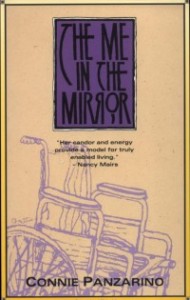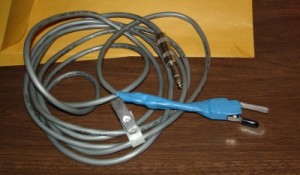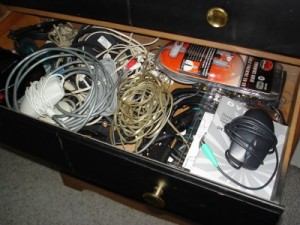This is the fourth in a series of articles about my recent trip to the emergency room, my intestinal surgery, and my recovery afterwards. Here is an index to all of the articles in this series.
There are two entrances to St. Vincent Hospital Emergency Room. The public entrance looks like most emergency room entrances with automatic sliding glass doors, a small lobby leading up to a triage desk, and an extensive waiting room. However when you come by ambulance you go down a ramp to an underground parking garage which is really nice if the weather is nasty. Today was a sunny day so it didn’t really matter. They wheeled me through a set of automatic doors, onto an elevator, up one floor and directly into the emergency room without waiting anywhere. Dr. Swinney’s office had called ahead to let them know I was coming so that seemed to expedite matters a little bit.
They wheeled me into a small examination room and transferred me from the ambulance gurney to the hospital gurney. Mom and Dad had followed in the van and Mom arrived very shortly after me while Dad found a parking place. I described my symptoms to a couple of nurses and told them about the rough night I had had. They always ask you to describe your pain on a scale from 1 to 10. I told them it was about a four continuously, a five when a cramp occurred, and seven or eight last night during the worst of it. Because I didn’t know if it was urinary or intestinal I knew the first thing they would want was a urine sample. It’s almost impossible for me to give one on demand but anticipating they would need one I saved a sample right before we called the ambulance at home and had brought it with me. My urologist keeps me in good supply of empty sample containers for just such a purpose.
The first actual doctor I saw was a female petite blonde intern whom I described as “to cute to live”. Her personality and looks were almost a stereotype or caricature of cuteness and perkiness. Don’t get me wrong… she didn’t appear to be the dumb blonde or airhead stereotype. She seemed intelligent, competent, in command of the situation, sensitive to what was going on with me and in every way very professional. She was just terminally, incurablly cute.
Among the things new doctors or nurses who encounter me want to know is what is the exact nature of my disability. It’s only been in the past few years that I’ve been able to give them a definitive description of my “diagnosis”.
I was born in 1955 and by the time I was the age of a toddler it was obvious that I wasn’t toddling. Although I could sit upright and sort of scoot on my belly, I never did crawl or walk as an infant. I had a little “spider” walker that they would sit me in with my feet on the floor but I never really could push it around with my legs. The best I could do is wiggle back and forth in it really hard and sometimes make it scoot on a very smooth floor. My parents took me to Riley Children’s Hospital here in Indianapolis for a diagnosis. It was pretty obvious had some sort of neuromuscular disease similar to Muscular Dystrophy. The doctors at Riley finally gave me the label “amyotonia congenita” which is Latin for “low muscle tone from birth”. It’s not really so much a diagnosis of a particular disease but it’s more of a description of symptoms at least in my opinion. It’s a term they used for a whole category of congenital neuromuscular diseases that they couldn’t really identify.
Since most doctors had never heard of amyotonia congenita and it wasn’t really a very useful term to begin with, whenever anyone asked me what I had I would just say “a form of muscular dystrophy but not the usual variety Duchenne’s muscular dystrophy“. It wasn’t a very satisfying answer because it sounded like you didn’t know what you really talking about but it was the best answer I could give.
When I was in my last year of college I got a part-time job as a computer programmer at the Indiana University Medical Genetics Research Department which ironically was housed in the basement of Riley Children’s Hospital where they originally couldn’t figure out what was wrong with me. This was long before the human genome project was under way. Genetics research involved looking at vast amounts of lab data on various genetic markers and trying to determine probabilities that if you had a particular marker you would pass along some genetic disease which was on a nearby section of chromosome. They had a database of over 15,000 families. A large section of the Dayton concerned families with Huntington’s disease. When genetic researchers elsewhere first identified the gene that causes Huntington’s disease, our database was used to verify their results.
I’ll never forget my interview for that job. I was in a room with the head of the department Dr. Donald Merritt, M.D. , Ph.D. and my mentor Dr. John Gersting from the computer science Department. Dr. Merritt asked me “What’s your diagnosis?” I didn’t understand at first. I thought he was wanting me to diagnose something. What he really wanted to know was “With what disease have you been diagnosed?” but he didn’t say that.
He finally asked me in plain English “What have you got? Why are you in a wheelchair?”
I explained to him that I had some sort of genetic neuromuscular disease similar to muscular dystrophy.
His reply was “well I can name about a dozen of those. Which one is it?” So I explained that they had called it amyotonia congenita but that was really just a symptomatic description and not a diagnosis.
He asked me “don’t you want to know which kind of muscular dystrophy you really have?”
My response was a very matter of fact “well Doc… when you can tell me which of those dozen kinds of M.D. you can cure… then I’ll worry about whether or not that’s the one I’ve got.”
He didn’t have much of a response to that. He later explained he just wanted to know if I was comfortable discussing my disability. He wanted to make sure I wasn’t overly sensitive or easily offended by discussing such things. My sort of snappy in-your-face reply to his inquiries gave him all the info he needed. I got the job and worked there the rest of that year and another year and a half after I graduated as well. At that point my disability (whatever the hell it was) started to get the better of me and I had to quit work because I didn’t have the stamina to work full-time.
As best I can recall it was sometime in 1998 that I was browsing around the Internet looking for some medical information and just for fun decided to search for “amyotonia congenita”. Fortunately I misspelled it “amytonia” without the extra “O” which appears to be somewhat a legitimate alternate spelling. One of the things I came across was a book called “Me in the Mirror” by Connie Panzario.
The back cover reads in part…
Writer, activist and artist Connie Panzarino was born in 1947 with the rare disease Spinal Muscular Atrophy Type III, formerly called Amytonia Congenita. Throughout a childhood filled with both pain and joy, she strove to define herself: “I knew I was different. Now I had a name for the difference, like being Italian or Jewish. I was an Amytonia. I didn’t understand if that meant that I would never walk, or if all it meant was lack of muscle tone. I didn’t know that most children with this disease die before they’re five years old.” In this deeply moving and eloquent memoir, Connie Panzarino describes her decades of struggle and triumph, her relationships with family members and long-time lover Ron Kovic (author of Born on the Fourth of July), her eventual turn to lesbianism, and her years of pioneering work in the disability rights movement. Filled with spirit, passion and defiance, The Me In The Mirror tells the story of a remarkable life.
I ordered the book from Amazon.com but never got around to reading it. Unfortunately Amazon now thinks I’m interested in radical lesbian feminist literature and keeps recommending such books to me but that’s another story.
So what the hell was Spinal Muscular Atrophy, Type III anyway? I’d never heard of it before. Apparently they had a new name for my old disease that sounded much more like a diagnosis than a description. They even had at least three different types of it. That led me to search on the phrase “Spinal Muscular Atrophy” and I found a whole host of information including some autobiographical articles from people who had the disease. In many instances it sounded like they were a fly on the wall in my life. They described almost exactly the same things I went through. The main resource for information was an organization called “Families of Spinal Muscular Atrophy” or FSMA.org on the Internet.
One of the things I learned about the disease was that there was a genetic test you can take that only required an ordinary blood sample to see if a particular section of your number five chromosome was messed up. I didn’t have a doctor who was specific to my disability. Years ago I had a long time connection with the Marian County Muscular Dystrophy Foundation which was a local United Way organization separate from the more famous MDAA group run by Jerry Lewis. At one time or another Mom and I had each served on their board of directors. They now go by the name “Muscular Dystrophy Family Foundation” I called an old friend at the foundation and she referred me to their doctor who in turn referred me to be Indiana University Medical Genetics Department which was where I worked some 20 years previously. They since had moved out of the dark basement of Riley Hospital into a more modern medical research building on the campus of IUPUI. I met with a genetic counselor who gave me some good information about the disease. They took a blood sample and a few weeks later I had a positive result for SMA. The difference between Type I, Type II and Type III is mostly the age of onset. Mine pretty much figures out to be Type II.
Of course I’m still in the same situation as I was when Dr. Merritt asked me my diagnosis… they still can’t cure any of them but at least there is really significant and promising research going on into disease. The bad news is that any treatment they come up with is going to be most effective for infants who have not yet spent their entire life dealing with the effects of the disease. On a positive note it has given me useful information should my sister Karen ever want genetic counseling about her or her infant son Cole. Genetic counseling for Karen was one thing Dr. Merritt suggested I should consider in deciding whether or not I should pursue a more detailed diagnosis. On the other hand my conversation with him was in the mid-1970s and they really hadn’t come up with the term Spinal Muscular Atrophy at that time.
So today when the interns or residents asking about my disability I can easily say I was diagnosed with Spinal Muscular Atrophy Type II and sound really impressive about it. Of course their is the same blank stare as if I had said “amyotonia congenita”. When they give me that blank stare I usually add “it’s a kind of genetic neuromuscular disease”. That tells them what they need to know. Now that we’ve figured out what was wrong with my muscles, now it was up to them to diagnose the pain in my belly.
They drew some blood and checked the urine sample. They also started an IV. It didn’t take long for the urine sample to come back negative so I knew it had to be intestinal. The bloodwork showed an elevated white cell count which was indicative of an infection somewhere but hell the 102.5 fever the night before had told me that much. Eventually a resident doctor came in and told me they were going to do a CAT scan. He also said he was leaving at 11 a.m. and would be turning my case over to the next resident.
They brought me in two huge styrofoam cups of lemonade laced with some sort of radiological contrast. I had 45 minutes to drink the first one… another 45 minutes to drink the other one… and then the CAT scan. It took me about 35 minutes to get the first one down. It’s pretty nasty stuff and it’s hard to drink such large volumes in a short amount of time. I barely got down 20% of the second cup and I just gave up. I told the nurse I couldn’t drink anymore. She said well if that’s the best I could do it would be okay. About a half-hour later they came and got me for the CAT scan. It was lunchtime by then so Mom and Dad took turns going to lunch while I was getting scanned.
They had just transferred me from the gurney to the CAT scan table when someone stuck their head in the door and told the technicians another patient was waiting. Apparently this patient had already had contrast material injected into them and had to be scanned immediately so they transferred me back to the gurney and had me wait in the hallway. It didn’t take very long and they eventually brought me back in, transferred me to the table and strapped me in.
I’m not claustrophobic but CAT scan machines are a bit scary for me. When I’m lying on my back my arms and legs flop in the direction they want to. I’m always concerned that my knee or elbow will be sticking out too far and get crunched as the table slides in and out on the machine. I always have the technicians make sure everything is tucked in and strapped down very well. The machine tells you when to hold your breath and when to breathe. It even has a little countdown clock that lets you know how long you have left to hold your breath which is especially nice for me because I can’t hold it more than a few seconds anyway.
When it was all over, I asked the technician if it came out okay since I didn’t drink the full amount of contrast liquid. She said the nurse had told her about my inability to drink it all. She then said “I don’t know how they determine who needs to drink the stuff and who doesn’t. Your scan came out just fine.” That implied to me perhaps they didn’t need to have me drink anything at all. They did give me other injectable contrast through my IV line. That kind of pissed me off.
I returned to my little ER cubicle and tried to relax. I hadn’t slept well the night before and I had been awake since 6 a.m. or so. While waiting, Mom joked that perhaps she needed to be seen in the ER as well. Weekend before last she had sprained her foot walking in the back steps at the lake. It had been very sore for a couple of days but then it got better. However it was getting worse again and after walking all over the hospital that day it was getting even worse. She didn’t do anything about it that day but a few days later while I was in hospital she went to her foot doctor and sure enough she had a broken toe. As I’m writing this, she is still limping around in an oversized shoe with her foot wrapped up.
Eventually I heard someone paged over the PA system with a phone call from radiology. I was 99% sure that was my report. A couple of minutes later the same doctor was paged with a call from Dr. Swinney was my primary care doctor. Now I was sure the diagnosis was finally in. The resident from the from the next shift whom I’d not yet met finally came in to talk to me with my official diagnosis.
“Your CAT scan shows air in your abdomen where it should not be. The most likely cause of this is a perforated intestine. You are probably going to have to have surgery. The surgeon Dr. Davis will be in to talk with you shortly. We’ve talked with Dr. Swinney and we are going to talk to your pulmonary doctor Dr. Vohra.”
The last sentence was the most important one in that diagnosis. Many times I had discussed with Dr. Vohra the possibility of having various surgeries. He always said that with my very weak lungs, there was always a danger they would have trouble getting me off of the ventilator after surgery. There was a real possibility I could be on the ventilator for days, weeks, or even the rest of my life. This was going to be pretty major surgery and if he signed off on it, that meant I really really needed it badly. The risks of not having surgery in this instance were going to be much greater than the risks of ending up on a ventilator the rest of my life.
The diagnosis was in. The solution was surgery. The risks were huge. Now I had to figure out how to deal with it.
In our next installment we supplement the medical care with spiritual care.


